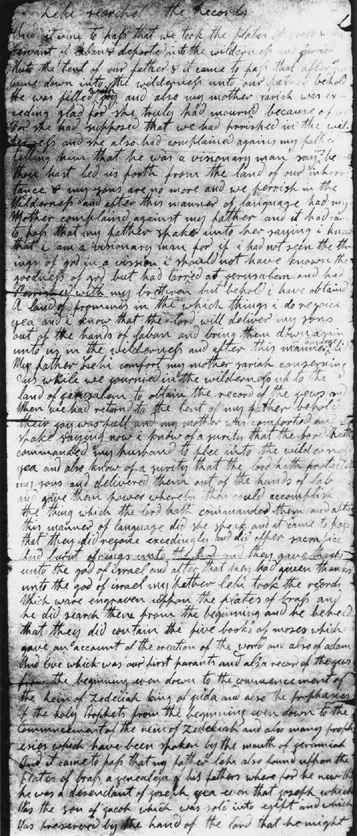
Book of Mormon Manuscripts |

A page from the original Book of Mormon manuscript, covering 1 Nephi 4:38-5:14. It shows how fluent Joseph Smith's dictation was. He did not change or revise the text as he dictated. Oliver Cowdery, one of his scribes, stated, "Day after day I continued, uninterrupted, to write from his mouth…a voice dictated by the inspiration of heaven."
by Royal Skousen
The printed versions of the Book of Mormon derive from two manuscripts. The first, called the original manuscript (O), was written by at least three scribes as Joseph Smith translated and dictated. The most important scribe was Oliver Cowdery. This manuscript was begun no later than April 1829 and finished in June 1829.
A copy of the original was then made by Oliver Cowdery and two other scribes. This copy is called the printer's manuscript (P), since it was the one normally used to set the type for the first (1830) edition of the Book of Mormon. It was begun in July 1829 and finished early in 1830.
The printer's manuscript is not an exact copy of the original manuscript. There are on the average three changes per original manuscript page. These changes appear to be natural scribal errors; there is little or no evidence of conscious editing. Most of the changes are minor, and about one in five produca a discernible difference in meaning. Because they were all relatively minor, most of the errors thus introduced into the text have remained in the printed editions of the Book of Mormon and have not been detected and corrected except by reference to the original manuscript. About twenty of these errors were corrected in the 1981 edition.
The compositor for the 1830 edition added punctuation, paragraphing, and other printing marks to about one-third of the pages of the printer's manuscript. These same marks appear on one fragment of the original, indicating that it was used at least once in typesetting the 1830 edition.
In preparation for the second (1837) edition, hundreds of grammatical changes and a few textual emendations were made in P. After the publication of this edition, P was retained by Oliver Cowdery. After his death in 1850, his brother-in-law, David Whitmer, kept P until his death in 1888. In 1903 Whitmer's grandson sold P to the Reorganized Church of Jesus Christ of Latter-day Saints, which owns it today. It is wholly extant except for two lines at the bottom of the first leaf.
The original manuscript was not consulted for the editing of the 1837 edition. However, in producing the 1840 edition, Joseph Smith used O to restore some of its original readings. In October 1841, Joseph Smith placed O in the cornerstone of the Nauvoo House. Over forty years later, Lewis Bidamon, Emma Smith's second husband, opened the cornerstone and found that water seepage had destroyed most of O. The surviving pages were handed out to various individuals during the 1880s.
Today approximately 25 percent of the text of O survives: 1 Nephi 2 through 2 Nephi 1, with gaps; Alma 22 through Helaman 3, with gaps; and a few other fragments. All but one of the authentic pages and fragments of O are housed in the archives of the LDS Historical Department; one-half of a sheet (from 1 Nephi 14) is owned by the University of Utah.
(See Basic Beliefs home page; Scriptural Writings home page; The Book of Mormon home page)
Bibliography
Heater, Shirley R. "Gold Plates, Foolscap, & Printer's Ink, Part I: Manuscripts of the Book of Mormon." Zarahemla Record 35-36 (1987):3-15.
Jessee, Dean C. "The Original Book of Mormon Manuscript." BYU Studies 10 (1970):259-78.
Encyclopedia of Mormonism, Vol. 1, Book of Mormon Manuscripts
Copyright © 1992 by Macmillan Publishing Company
All About Mormons |